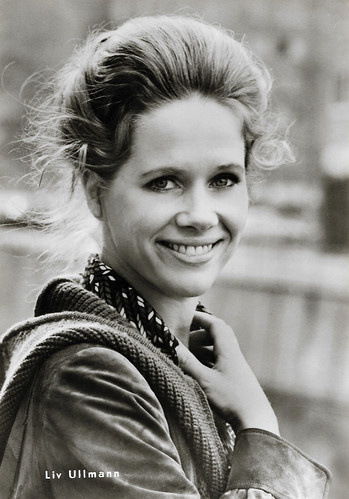
East German autograph card by VEB Lied der Zeit, Berlin. Photo: Günter Linke.
Frank Schöbel (1942) was one of the most successful pop singers in socialist East Germany (GDR) and remained so after the German reunification. He also appeared as a presenter and entertainer in TV shows and played in DEFA films. In 1971, he recorded 'Wie ein Stern' (Like a Star), a smash hit that later appeared in the acclaimed film Das Leben der Anderen/The Lives of Others (2007). Schöbel was married to the actress and singer Chris Doerk, with whom he often performed in the 1960s and 1970s.

East German postcard by VEB Progress Film-Vertrieb, Berlin, no. 241/70, 1970. Photo: Linke.
French actress Marie-José Nat (1940-2019) was an acclaimed stage, film and television star, who played glamorous, exotic roles in many European films of the 1960s and 1970s.

East German postcard by VEB Progress Filmvertrieb, no. 105/71, 1971. Photo: Linke.
In the 1960s and early 1970s, German actress Traudl (or Traudel) Kulikowsky (1943) was one of the most popular young actors of the DDR (GDR), also because of her youthful, fresh appearance. After the Wende, it became known that she also had worked as a Stasi spy.

East German postcard by VEB Progress Film-Vertrieb, Berlin, no. 208/71, 1971. Photo: Linke.
French actor Jean-Pierre Léaud (1944) is best known for playing Antoine Doinel in Les Quatre Cents Coups/The 400 Blows (1959) and François Truffaut's following series of films about that character. He also worked several times with Jean-Luc Godard and is one of the icons of the French New Wave. He is also known for his staccato diction.

East German postcard by VEB Progress Film-Vertrieb, Berlin, no. 151/72, 1972. Photo: Linke.
Eva Lorenzová (1948) is a Czech actress, who appeared in supporting parts in a dozen Czech films during the 1970s.

Big East-German card by VEB Progress Film-Vertrieb, no. 2/74, 1974. Photo: Linke.
German actress Renate Blume (1944) has appeared in more than 70 films and television shows since 1964. Her film debut Der geteilte Himmel/Divided Heaven (Konrad Wolf, 1964) was an international success and later she co-starred in Easterns with Gojko Mitic and Dean Reed.

East German postcard by Progress Film-Verleih, Berlin, no. 23/74, 1974. Photo: Linke.
Cox Habbema (1944-2016) was a Dutch actress, stage director, writer, and former managing director of the Municipal Theater in Amsterdam. From 1969 to 1984 she mainly lived and worked in East Berlin, where she appeared in several films. Among her Dutch films is Marleen Gorris' controversial thriller De stilte rond Christine M./A Question of Silence (1982).

East German postcard by VEB Progress Film-Vertrieb, Berlin, no. 128/74, 1974. Photo: Linke.
East German actress Angelika Waller (1944) appeared in more than a hundred films and TV productions since 1962. Her first leading role was in Das Kaninchen bin ich/The Rabbit Is Me (1965), a film which was banned in East Germany and which had its world premiere only in 1989.

East-German postcard by VEB Progress Film-Vertrieb, Berlin, no. 172/74, 1974. Photo: Linke.
Czech actress Andrea Čunderlíková (1952) appeared in films, on stage and television. She began in 1964 as a child star in Czech cinema and later became a star as Nurse Ina in the popular Czech TV series Nemocnice na kraji města/Hospital on the Edge of the City (1978-1981).

East German postcard by Progress Film-Verleih, Berlin, no. 46/75, 1975. Photo: Linke.
American actress Jane Fonda (1937) is a two-time Academy Award winner for the crime thriller Klute (1971) and the Vietnam drama Coming Home (1978). Roger Vadim's psychedelic Science Fiction spoof Barbarella (1968) made her one of the icons of the European cinema of the 1960s. In 2014, she received the American Film Institute AFI Life Achievement Award.

East German postcard by Progress Film-Verleih, Berlin, no. 32/76, 1976. Photo: Günter Linke.
Norwegian actress and film director Liv Ullmann (1938) was the muse of filmmaker Ingmar Bergman. She starred in 10 of Bergman's films, including Persona (1966), Vargtimmen/Hour of the Wolf (1968), Skammen/Shame (1968), Viskningar och Rop/Cries and Whispers (1972), and Höstsonaten/Autumn Sonata (1978), with Ingrid Bergman. She co-acted often with Erland Josephson, with whom she made the television drama Scener ur ett äktenskap/Scenes from a Marriage (1973), which was also edited into a feature. Ullmann was twice nominated for an Oscar, for Jan Troell's Utvandrarna/The Emigrants (1971) and Ingmar Bergman's Ansikte mot ansikte/Face to Face (1976).

East German postcard by VEB Progress Film-Vertrieb, Berlin, no. 92/76, 1976. Photo: Linke.
Blanche Kommerell (1950) is a German actress and writer. She has appeared in more than fifty films since 1962.

East German postcard by VEB Progress Film-Vertrieb, Berlin, no. 100/76, 1976. Photo: Linke.
Helena Vondráčková (1947) is a Czech singer and actress whose career has spanned five decades. She is the best-selling singer ever in her country. The Czech pop diva also appeared in films and stage musicals.

East German postcard by Progress Film-Verleih, Berlin, no. 154/76, 1976. Photo: Linke.
Film actress, singer and director Anna Karina (1940-2019) was the Queen of the Nouvelle Vague (the French New Wave). French, but Danish-born Karina was the muse of director Jean-Luc Godard and starred in eight of his films.

East German postcard by Progress Film-Verleih, Berlin, no. 15/80. Photo: Günter Linke, 1979.
Cleft-chinned and steely-eyed American superstar Kirk Douglas (1916-2020) made his film debut in The Strange Love of Martha Ivers (1946) with Barbara Stanwyck. The legendary actor, producer and director soon developed into a leading box-office star throughout the 1950s, known for serious dramas, including Westerns, war films and two classics made by Stanley Kubrick, Paths of Glory (1957) and Spartacus (1960). During his long career, he appeared in more than 90 films.
Source: Filmmuseum Potsdam (German).
1 comment:
Günter Linke's photography offers a captivating glimpse into the world of East German and international cinema. check out Zenith Clipping. Their professional editing services can help bring your creative vision to life. Keep creating and inspiring! 🎨
Post a Comment